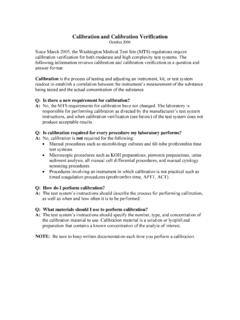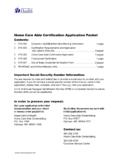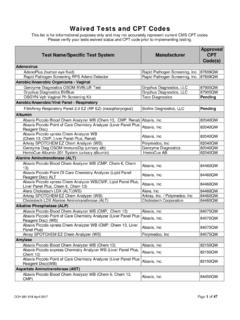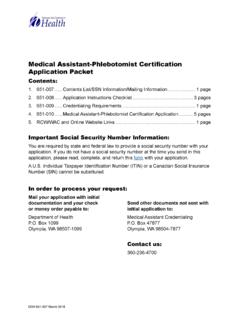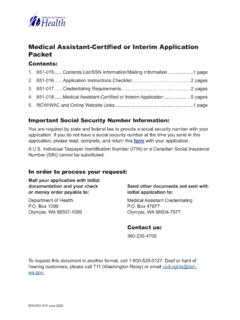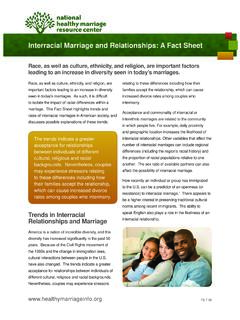Transcription of Multicultural Awareness: Working with Diverse Participants ...
1 Multicultural Awareness: Working with Diverse Participants Multicultural Awareness: Working with Diverse Participants Adapted from the California WIC Program for the Washington State WIC Nutrition Program Multicultural Awareness: Working with Diverse Participants - 2 - TABLE OF CONTENTS 1 What Is Culture?.. 2 Some of the Cultures Served by 3 Why Is Culture Important? .. 4 About 7 Cultural 8 Working with the Participant Whose Culture Differs from 10 Communicating with Someone Who s Language You Do Not 12 LEARNING 14 1: What Is Your Culture?
2 15 2: Cultural Beliefs and 17 3: A Co-Worker s 19 4: When I am Culturally Competent .. 22 5: Understanding the Cultures Served by Your WIC Agency .. 23 6: Communicating with People Whose Language Is Different than Yours .. 27 7: Role 29 31 Multicultural Awareness: Working with Diverse Participants 1 OVERVIEW Introduction The Participants at WIC come from a variety of backgrounds and cultures. This module will help you to welcome and appreciate the diversity and differences at WIC. Learning Objectives After completing this module you will be able to: Define culture and identify five elements of culture.
3 Explain how two Diverse cultures can interpret the same non-verbal cue differently. Explain how culture affects health and dietary behaviors. Explain how the first and second generations of a culture may have different beliefs and behaviors related to WIC services. Provide examples of how communication differs with people speaking various languages. Provide examples of how cultural factors can impact WIC services. Provide examples of a Culturally Competent Person. Communicate across cultures. continued on next page Multicultural Awareness: Working with Diverse Participants 2 WHAT IS CULTURE?
4 Definition Culture is: the shared values, beliefs, views, traditions, norms, customs, arts, folklore, and history of a group of people. Elements of Culture Elements of Culture include: race or ethnicity , country of origin, roles of women and men, age, religion or spiritual practice, language or dialect, food, common beliefs, sexual orientation, family structure, residence, education, Socioeconomic status, profession and/or health status. Why is culture important? Culture greatly affects our health decisions, it can affect our behaviors about: diet and nutrition, pregnancy, breastfeeding, alcohol and drug use, family planning, and health care.
5 Culture is NOT Just ethnicity Culture includes our ethnicity but isn t limited to ethnicity . For example, you may identify with people who share your ethnic background, but may identify more with people who share your religious beliefs. Multiple Cultures People often relate to many cultures. For example, a person may be Hispanic, have grown up in a rural community, speak only English, and be a single mother. She may identify with at least 4 cultures. Types of Cultures WIC serves people of many cultures. The chart on the following page gives you a list of some of the characteristics of cultures and an example of each.
6 Multicultural Awareness: Working with Diverse Participants 3 SOME OF THE CULTURES SERVED BY WIC Cultural Characteristics DESCRIPTION People of this culture identify with people who: EXAMPLE An example of the representative culture could be: Age are similar in age teenagers Country of Origin were born or grew up in the same country Laotian immigrants ethnicity are of the same ethnic background Chinese Americans Family Structure have a similar family make up single mothers Gender are of the same sex male WIC Participants Health Status have a similar health condition a person with diabetes Income make about the same amount of money TANF (welfare)
7 Recipients Language speak the same language Spanish-speaking Participants Religion share similar religious beliefs Seventh Day Adventists Residence live in the same area people living in a migrant camp Work do similar work Nutrition Assistants Learning Activity Learning Activity: What is Your Culture? Complete this learning activity at the end of this module to help you learn more about your culture. Multicultural Awareness: Working with Diverse Participants 4 WHY IS CULTURE IMPORTANT? A Design for Living Culture gives people a design for living.
8 It is a group s: Assumptions about the world Goals and meanings of life Views about what is right and what is wrong Views of what is important and what isn t, and Beliefs about how to behave and how to expect others to behave. (adapted from a definition by Noel Day, Porlaris Research and Development, San Francisco) Culture helps people structure their community and family life. Culture Affects Beliefs, Values, and Behaviors A person s culture often determines her/his: beliefs, values, and behaviors. Beliefs Beliefs are what a person views as true in life and/or death.
9 For example, Buddhists believe suffering is part of life. Values Values are what a person sees as important or meaningful in life. For example, many people in the United States value time and see time as money. Behaviors Behaviors are what a person does. For example, exercising is a healthy behavior. continued on next page Multicultural Awareness: Working with Diverse Participants 5 WHY IS CULTURE IMPORTANT? (continued) Culture Affects Health Behaviors Culture greatly affects our health decisions. It can affect our behaviors about: diet and nutrition, pregnancy, breastfeeding, alcohol and drug use, family planning, and health care.
10 Examples of How Culture Affects Health The chart on the next page shows some examples of how culture can affect health and nutrition beliefs and behaviors. Learning Activity Learning Activity 2: Cultural Beliefs and Behaviors Complete this learning activity at the end of this module to help you learn more about how culture affects our health beliefs and behaviors. Multicultural Awareness: Working with Diverse Participants 6 WHY IS CULTURE IMPORTANT? (continued) Some Examples of Belief Systems and How They Affect Health and Nutrition TOPIC EXAMPLE Diet And Nutrition Chinese recipes use tofu (bean curd) more often than dairy products.
